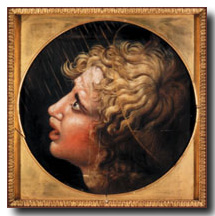Outback Benedictines adopt cultural business methods
- SAMSON SPANIER
Your drawing is much better than ours.: So said Hugo Chapman of the British Museum when confronted with a tempera study of a head from Raphaels workshop. This head of an apostle is notable not only for its quality but also for its ownership: the community of Benedictine monks of New Norcia, western Australia.
 |
New
Norcia Benedictine Monastery |
New
Norcia is a hodge-podge of curiosities where anything might still turn up. The
secret is now out, and since the discovery of the Raphael/Giulio Romano, scholars
and auction houses have surveyed the paintings, none more so than Nicholas Lambourne
of Christies. The works on paper, of which there are tens of thousands, may still
conceal finds.
New Norcia is now a tourist attraction, owing to its quirkiness.
It is a 19th-century Spanish town, complete with churches and master woodwork
imported by Europeans, that just happens to be located 130 km from Perth, where
farm land begins to give way to the outback. It may become one of the few Unesco
World Heritage Sites in Australia and is also the only place in the world where
one can see both a Giulio Romano, and a kangaroo hopping down the street.
The paintings collection is of mostly Caravaggesque oils from Spain and Italy.
There are a few good originals, such as a Holy Family and a Rest on the flight
to Egypt by Giovanni Bernardino Azzolino, as well as works by Tomaioli, Giacinto
Brandi, and the circle of Orazio Riminaldi. The majority are copies, as befits
a a relatively poor mission sent round the world. The Giulio Romano, on the other
hand, has an exceptional provenance. It was bought for purely religious reasons
in 1941 at an auction of deaccessioned works from the National Gallery of Australia.
 |
Head
of an Apostle from Raphael's workshop, probably by Giulio Romano |
As
for artefacts and the like, everything has been kept, from the first abbots gold
teeth to a chalice given by Isabella II of Spain. A forage into the library recently
revealed a rare 18th-century copy of a 15th-century Hebrew book, the Shoshan
Sodot. The library also contains some of the best studies of Australian flora,
donated by a botanist who joined the brotherhood.
New Norcia, however,
suffers from problems that stem from the fact that it was never intended to be
a museum. It was originally a colonial mission of 80 monks, with a school and
orphanage for Aboriginals, which in total numbered 500 residents. The school closed
in 1991, and the 14 monks nearly shut up shop. With a tenacity not unrelated to
religious zeal, they have survived by promoting tourism and branded goods, including
guesthouses and fresh bread. The discovery of the Giulio Romano was a direct result
of this push.
This business-like restructuring, however, worries the
more contemplative monks. New Norcia now has 60,000 visitors per year and a business
for its branded foods. Remarkably enough, the latest addition is an exhibition
about space travel, inspired by the arrival of a European space agency research
station nearby hardly the contemplation of the heavenly host that the founders
had in mind.
The man behind this adaption of New Norcia to museum and
cultural centre is Dom Christopher Power, Procurator of the Monastery. He claims
that Aus$12 million ($7.2 million, £4.6 million) are needed merely to restore
the buildings. Much of his time is taken up with applying for grants and overseeing
business plans.
For the art lover, however, the news is good. No religious
piece would ever be sold, so New Norcia will not trade its artefacts for financial
comfort. Moreover, new works may well come to light. I asked Dom Chris if anything
had turned up in the works on paper: Well, he said with his polite Australian
twang, Ive found this etching which might I repeat might be by Rembrandt.
Ill ask Nicholas Lambourne next time he visits...
Click here to visit the New Norcia Monastery web site
 This is Meaghen Gonzalez, Editor of CERC. I hope you appreciated this piece. We curate these articles especially for believers like you.
This is Meaghen Gonzalez, Editor of CERC. I hope you appreciated this piece. We curate these articles especially for believers like you.
Please show your appreciation by making a $3 donation. CERC is entirely reader supported.

Acknowledgement
Samson Spanier. "Outback Benedictines adopt cultural business methods." The Art Newspaper.
Reprinted with permission from The Art Newspaper.




